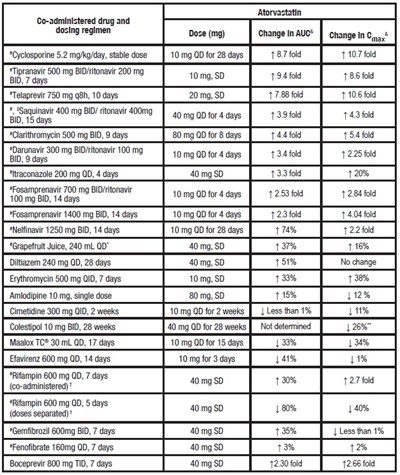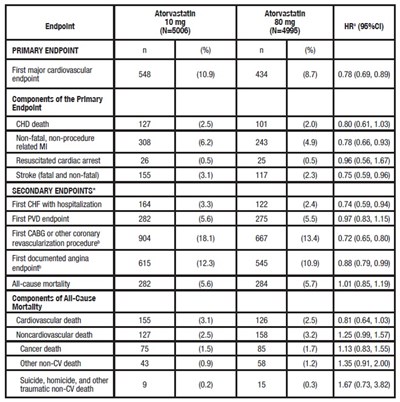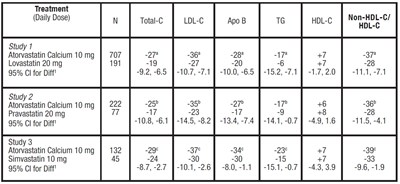Product Images Atorvastatin Calcium
View Photos of Packaging, Labels & Appearance
Product Label Images
The following 12 images provide visual information about the product associated with Atorvastatin Calcium NDC 71610-094 by Aphena Pharma Solutions - Tennessee, Llc, such as packaging, labeling, and the appearance of the drug itself. This resource could be helpful for medical professionals, pharmacists, and patients seeking to verify medication information and ensure they have the correct product.
Bottle Label 80 mg - 71610 0094 15

This is a medication called Atorvastatin Calcium that comes in a pack of 15 tablets containing 80mg of the active ingredient. It is identified by a reference number NOC# 71610.0004-15. It is not clear what the abbreviation LI means as there isn't enough context.*
Figure 3 - F3

This is a statistical report that presents the percentages of subjects who experienced an event under different dosages of Atorvastatin medication (10 mg and 80 mg). The report also includes the Hazard Ratio (HR) and corresponding p-value indicating the effectiveness of Atorvastatin in reducing the risk of Major Cardiovascular Endpoint. Finally, the report presents a graph showing the time it took for the first Major Cardiovascular Endpoint to occur during the study period of 5 years.*
Table 3 - T3

This is a table showing the results of a study with different doses of a certain medication and their respective number of participants (N) for each dose, as well as the occurrence of adverse reactions. The adverse reactions are listed at the end of the table and their respective percentages of occurrence are also shown. There is also a note in the middle of the table indicating that the study was conducted in 2008 and 2018 but it is unclear what this refers to. The text in the lower section of the image is not readable.*
Effect of Co-administered Drug - T4

This is a table of drug interactions involving Atorvastatin and the effects on the area under the plasma concentration versus time curve (AUC) and maximum plasma concentration (Cmax). The table includes various drugs such as Cyclosporine, Clariromycin, and Erythromycin along with the dosing regime, dose, and change percentage in AUC and Cmax. Additionally, the table shows that some of these drugs have no change in AUC and Cmax, while others have significant changes in AUC and Cmax.*
Effect of Atorvastatin - T5

This document appears to be a record of various medications and dosages taken over a period of time. Specifically, it mentions the use of Atorvastatin at 80mg, then 40mg once daily for varying durations, as well as the use of Antipyrine at 600mg as a single dose. It also lists the taking of birth control pills for two months, and the use of the medications Tipranavir and Fosamprenavir for 7-14 days each. Finally, this document includes measurements in percentages labeled "Auc Change in Cp" and "reg|," the meaning of which is unclear without further context.*
Table 6 - T6

This text appears to be a summary of a medical study that investigates the efficacy of atorvastatin in reducing cardiovascular events. It provides details about the number and percentage of patients who experienced a primary endpoint (which included major cardiovascular events), as well as various secondary endpoints (such as coronary revascularization procedures or angina). The study also reports on mortality rates, including cardiovascular and non-cardiovascular deaths. The text is not very readable due to errors and incomplete formatting.*
Table 8 - T8

This text appears to be the results of a study comparing the effectiveness of different doses of various medications (Atorvastatin Calcium, Lovastatin, Pravastatin, and Simvastatin) on the reduction of Non-HDL-C/HDL-C levels. The results include the name and daily dose of each medication used in each study, as well as a 95% confidence interval for the difference in their effectiveness in reducing Non-HDL-C/HDL-C levels.*
* The product label images have been analyzed using a combination of traditional computing and machine learning techniques. It should be noted that the descriptions provided may not be entirely accurate as they are experimental in nature. Use the information in this page at your own discretion and risk.




